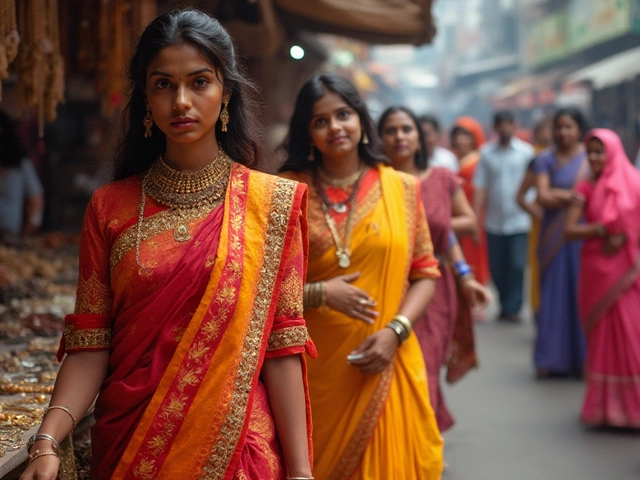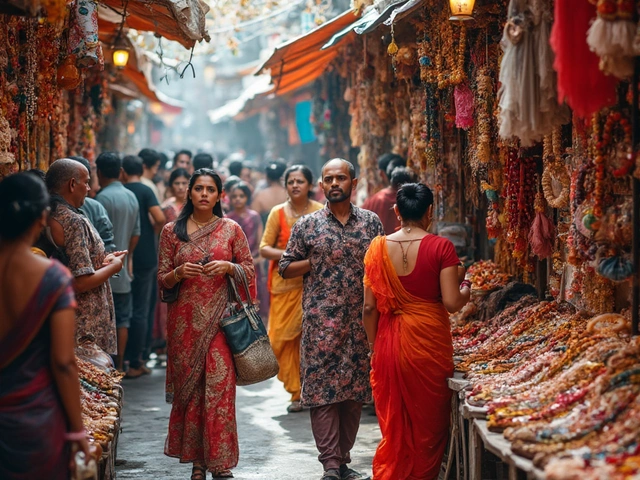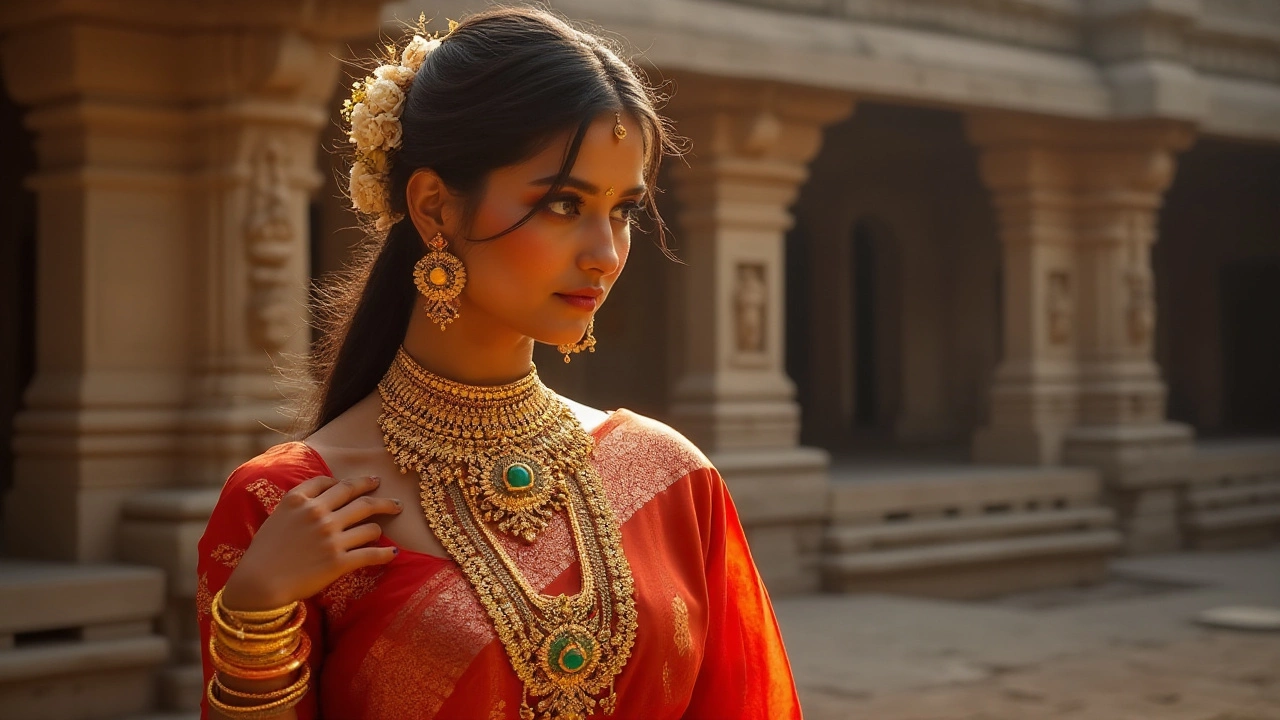
Indian jewelry is not just a piece of adornment; it's a celebration of art, culture, and history. Wearing jewelry in India is steeped in tradition and has a story that goes beyond personal aesthetics. With roots deeply entwined in religious and cultural practices, temple jewelry holds a place of reverence in Indian society.
Often crafted with intricate details and adorned with precious stones, temple jewelry reflects the artistry of ancient craftsmen who created pieces to honor the deities. These jewels were originally designed to adorn idols in temples, later becoming an essential element in traditional Indian bridal and festive attire.
Diving into the world of Indian temple jewelry unveils a realm where gold is not just metal, but a symbol of purity, power, and prosperity. The quintessential motifs included in these pieces evoke tales from ages past, marrying aesthetic appeal with spiritual depth.
- Historical Background of Indian Jewelry
- Cultural Significance and Symbolism
- The Craftsmanship of Temple Jewelry
- Materials and Techniques Used
- Jewelry in Modern Times
- Tips for Incorporating Temple Jewelry into Your Wardrobe
Historical Background of Indian Jewelry
The history of Indian jewelry spans over thousands of years, reflecting the vast diversity and rich traditions of the subcontinent. The very earliest signs of jewelry-making have been traced back to the Indus Valley Civilization, which flourished around 2500 BCE. Archaeologists have unearthed artifacts and beads made from gold, silver, and various stones in sites like Mohenjo-Daro and Harappa, marking the beginning of a long and illustrious tradition. These pieces were not just for adornment but were integral in trade and cultural exchanges with neighboring regions.
During the Vedic period, roughly between 1500 and 500 BCE, jewelry began to take on more nuanced roles within society, aligning closely with religious and societal norms. It was during these times that the concept of adornment started becoming significant in ceremonies and rites of passage. Jewelry was used not only by women but by men too, often symbolizing status, wealth, and power. References to jewelry in ancient Indian literature, including the Rigveda, are abundant, highlighting its importance.
A significant transformation came during the Mauryan Empire (322–185 BCE) when the influence of Buddhism began to permeate Indian culture. Emperors like Ashoka propagated the spiritual and philosophical tenets of Buddhism, which resulted in jewelry serving as amulets and talismans imbued with religious significance. This period saw the rise in popularity of simpler designs owing to the influence of asceticism which Buddhism emphasized, yet the cultural significance of precious metal craftsmanship grew manifold.
The Mughal era marked a golden age for Indian jewelry. From the early 16th century, with the advent of the Mughals, Indian artisans were introduced to advanced techniques and a broader vision of ornate designs. This era contributed to the opulence associated with temple jewelry today. The infusion of Persian aesthetics ushered in elements such as the use of kundan, a form of gold jewelry setting, and meenakari, the art of enameling. Renowned Mughal emperors adorned themselves and their courts with grandai designs that became emblematic of their reign. Jahangir's memoirs, Jahangirnama, provide personal insights into the role and appreciation of jewelry during his rule.
The historical journey of Indian jewelry is not complete without acknowledging the colonial influences of the British Empire from the 19th to mid-20th centuries. Though initially threatening to local crafts, this era brought about the globalization of Indian jewelry aesthetics, as traditional designs gained an audience outside of India. It was during this time that temple jewelry began to be recognized as art pieces rather than mere religious adornments. While the British promoted their styles, Indian artisans retained traditional methods, which led to an interesting amalgamation that sustained the craft's prosperity through centuries.
In fact, one of the remarkable aspects of
Indianness in jewelry is its transcendental quality, enveloping not just utility or aesthetic pleasure but a sort of spiritual resonance," noted noted Indian historian Krishnan Kripa.Such views underscore how jewelry remains intertwined with India's socio-cultural fabric, echoing both the simplicity of its early beginnings and the mystique of its ornate evolutions. This richness in history echoes through each piece, making it not just an accessory but a story within the patina of time.
Cultural Significance and Symbolism
In Indian culture, jewelry is not merely an accessory; it is a vital element that narrates the tales of heritage, spiritual beliefs, and social norms. The importance of adornments like Indian jewelry is deeply rooted in the societal fabric, playing a pivotal role during religious ceremonies, weddings, and various auspicious events. Wearing jewelry is considered a means of connecting with the divine and seeking blessings from higher powers. The intricate designs and motifs in temple jewelry often depict gods and goddesses, symbolizing sacred tales from Hindu mythology.
The evolution of temple jewelry began with its association with deities. In ancient times, temples were not just places of worship but centers of art and culture. The sculptures and idols adorned with jewelry were a status of reverence, reflecting the community's collective devotion and prosperity. This form of jewelry emerged during the Chola dynasty, known for its prominent use of gold and precious stones. As a result, temple jewelry became synonymous with wealth, power, and divine protection, symbolizing the spiritual wealth of a society.
The symbolic motifs found in temple jewelry carry profound meanings. For instance, the lotus flower design signifies purity, enlightenment, and self-regeneration. Peacock motifs represent grace and beauty, while the elephant is a sign of good fortune and longevity. Each piece of jewelry encapsulates symbols that enhance the wearer's aura and spiritual alignment. The cultural significance of adorning oneself with such jewelry goes beyond aesthetics, as it also serves as an expression of identity and pride in one's heritage.
In modern times, the charm of temple jewelry has seen its resurgence, not just within India but globally. Many designers and connoisseurs draw inspiration from traditional pieces, integrating them into contemporary fashion. These jewels have transcended geographical boundaries, becoming a symbol of Indian artistry appreciated by jewelry enthusiasts worldwide. The role of this ornate jewelry in cultural identity cannot be overstated; it acts as a conduit between past and present, allowing individuals to embrace their ancestral heritage while adapting to the current world.
"Jewelry is a very personal thing… it should tell a story about the person who’s wearing it," said Garance Doré, emphasizing the inherent narrative and cultural undertones associated with adornments.
One cannot discuss the cultural significance of Indian jewelry without acknowledging its role in ceremonies like weddings. Intricately designed pieces are often passed down through generations, each band, necklace, or bangle narrating stories of joy, sacred ceremonies, and familial ties. The practice of gifting jewelry during weddings or festivals is a tradition laden with symbolic meaning and emotional value, representing blessings for a prosperous and harmonious life. The legacy that temple jewelry carries is that of embodying the intersection between tradition and evolving cultural identity, highlighting the timeless allure of this cherished craft.
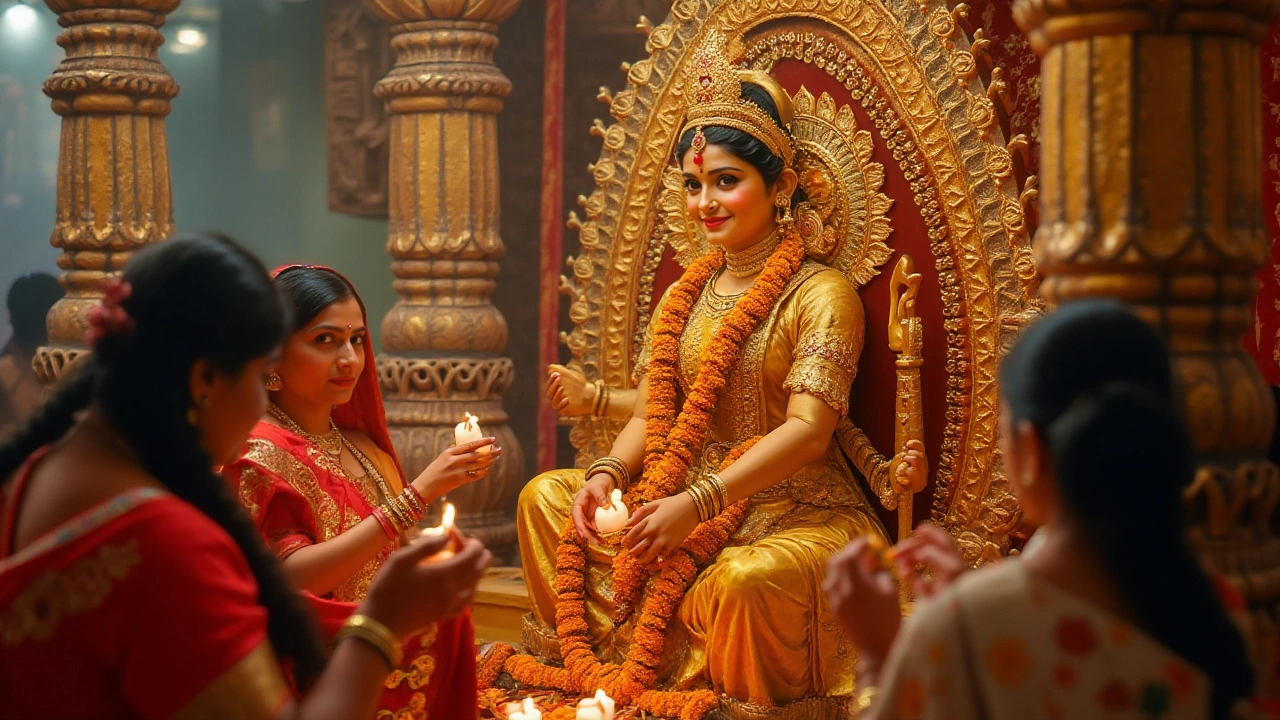
The Craftsmanship of Temple Jewelry
The art of crafting temple jewelry is a meticulous process that has been honed over centuries, passed down through generations of skilled artisans. Each piece is a labor of love, combining the artisan's intricate handwork with traditional methods that have stood the test of time. At the heart of this craft is the ability to translate spirituality and mythology into dazzling creations that reflect India's cultural tapestry. The process begins with the careful selection of materials, predominantly gold, known for its purity and lustrous finish. Gold serves as the canvas upon which artisans etch stories of gods and goddesses, creating a synergy between the divine and the earthly realm. The use of precious stones such as rubies, emeralds, and pearls further enhances the opulence of these intricate designs.
The creation of temple jewelry involves various techniques that highlight the artisans' mastery over their craft. Techniques like filigree and repoussé speak to the artisans' ability to manipulate metal into delicate patterns that mimic forms from nature and mythology. Filigree work, for instance, involves twisting delicate metal threads into lace-like patterns that are both lightweight and structurally strong. The finesse required for this technique is remarkable, often requiring years of practice to perfect. Repoussé, on the other hand, is a technique where the metal is shaped by hammering from the reverse side to create a raised design on the front. This method allows for stunning relief work, bringing characters and stories to life in three dimensions.
In many workshops, the creation process is collaborative, involving stone setters, engravers, and polishers, each playing a pivotal role in ensuring the piece is perfected to the smallest detail. The setting of precious stones is itself an art form, requiring precision to ensure the stones are both secure and prominently displayed. The skillful hands of the artisans bring to life motifs such as the lotus, elephants, peacocks, and religious symbols, each holding a particular significance. The lotus, often featured for its symbolism of purity and enlightenment, is a testimony to the deep layers of meaning embedded within each design.
According to renowned jewelry historian Dr. Vandana Boaz, "Temple jewelry is a unique testimony to India's cultural depth and incredible talent in craftsmanship. Each piece is not just an ornament; it's a celebration of history, religion, and life's opulent expressions."
Artisans often embody the legacy of their forefathers, adhering to traditional norms while occasionally incorporating modern techniques to appeal to contemporary tastes. Yet, the core of their work remains rooted in the authentic methods that have characterized temple jewelry for ages. This balance between historic craftsmanship and modern aesthetics allows temple jewelry to maintain its relevance and popularity in today's diverse fashion landscape.
The durability of Indian jewelry techniques is evident in how these pieces withstand the ravages of time, often becoming heirlooms passed down through families. They connect generations, serving as constant reminders of heritage and ancestral pride. Craftsmanship lies at the confluence of creativity, spirituality, and meticulous labor, ensuring temple jewelry remains both a timeless adornment and a profound narrative of India's rich tradition.
Materials and Techniques Used
The art of crafting Indian temple jewelry involves a fascinating journey from raw metals to stunning adornments, showcasing an impeccable attention to detail. Primarily, this jewelry is crafted from pure gold, which sets the benchmark for both its aesthetic and spiritual significance. In Indian tradition, gold is much more than a precious metal; it is a symbol of auspiciousness and divinity, often associated with the goddess Lakshmi, who embodies wealth and prosperity.
To bring these pieces to life, artisans employ age-old techniques that have been passed down through generations. These methods encompass an intricate process of molding, engraving, and embedding stones. One particularly renowned method is the 'filigree' technique, where delicate patterns are crafted by twisting and curling thin gold wires. This not only highlights the craftsmanship but also adds a sense of intricacy and elaborate beauty to each piece.
Temple jewelry is often embellished with precious and semi-precious stones such as rubies, emeralds, and pearls. The careful selection of these stones, based on color and size, adds vibrancy and enhances the overall design. The stones are meticulously embedded into the metal surface, often using the 'kundan' setting method, which involves mounting stones in a pure gold foil to highlight their brilliance. This gemstone inclusion reflects the grandeur and opulence of traditional Indian ornaments.
An interesting element in temple jewelry creation is the use of motifs inspired by deities and nature. Various engravings of peacocks, elephants, and floral designs pay homage to the rich cultural heritage and spirituality. These motifs are painstakingly molded and spaced to create harmony and balance, resulting in pieces that are not only visually appealing but also narratively deep.
To ensure the highest standards of craftsmanship, artisans spend a considerable amount of time perfecting their work. It is not uncommon for a single piece to take several weeks, or even months, to complete. This dedication to quality is partly why temple jewelry holds such a revered position in Indian culture. "The devotion and patience artisans invest in crafting temple jewelry is akin to a religious offering," remarks cultural historian Dr. Abhilash Nair.
The influence of temple jewelry has extended beyond traditional settings. Modern designers have begun to incorporate these traditional elements into contemporary fashion, broadening its appeal to a new generation. This blend of old and new ensures that temple jewelry continues to captivate and inspire fashion enthusiasts around the world. The use of pure materials and time-honored techniques stand as a testament to the enduring legacy and timeless allure of Indian jewelry.
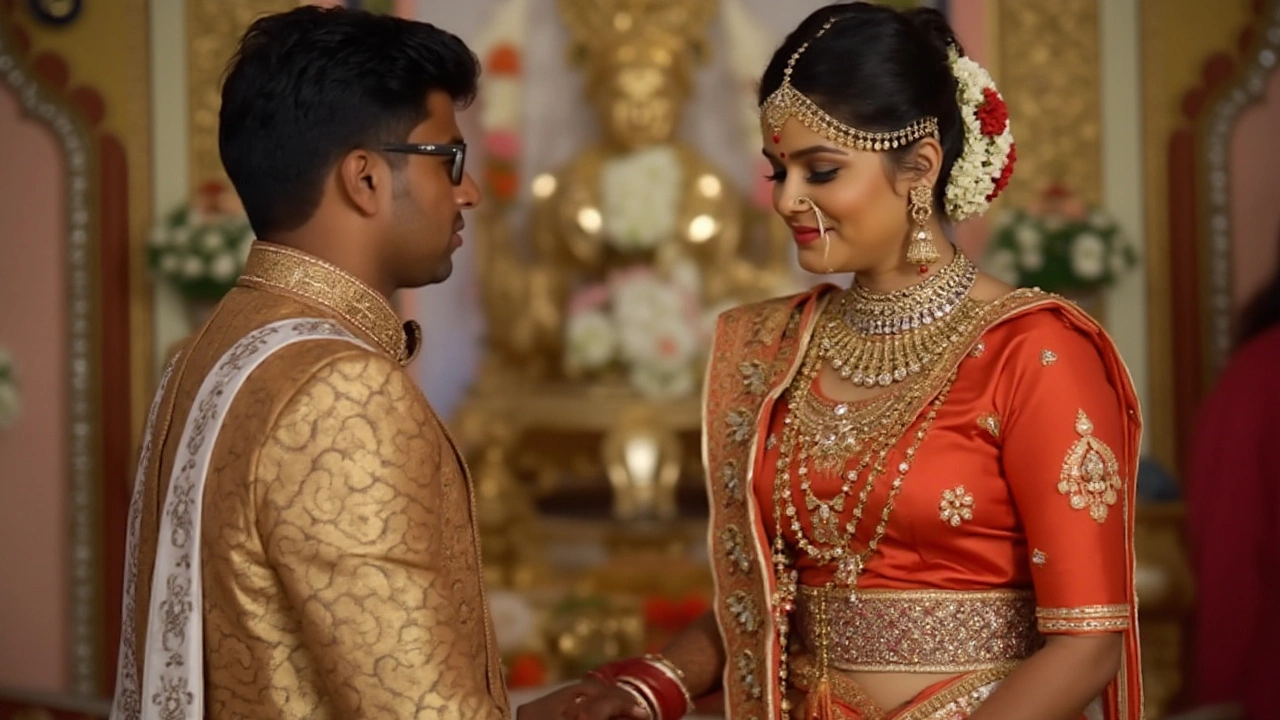
Jewelry in Modern Times
The allure of Indian jewelry continues to captivate today's fashion-forward individuals, seamlessly blending time-honored traditions with contemporary styles. In recent years, there's been a marked resurgence in the popularity of temple jewelry, with its intricate craftsmanship and cultural significance. The younger generation is drawing inspiration from their heritage and boldly incorporating these pieces into modern wardrobes, often mixing them with Western fashion elements to create a unique style statement.
This renaissance in temple jewelry is partly due to the influence of Indian cinema and television, where traditional adornments are frequently showcased in all their glory. As Bollywood stars don elaborate jewelry pieces, their admirers and viewers aspire to emulate such styles, rekindling interest in these magnificent pieces. Designers have responded to this renewed enthusiasm by integrating old-world charm with new-age aesthetics, making temple jewelry not just relevant but desirable in the urban landscape.
Renowned jewelry exhibitions and trade fairs have also played a pivotal role in bringing this art form to the global audience. By showcasing intricate designs and educating potential buyers on their significance, these platforms have opened up international markets. It has led to an increase in exports, where temple jewelry is appreciated not just for its beauty but as a statement of cultural identity. As the global appreciation grows, so does the expertise and creativity of artisans who are now experimenting with newer techniques and materials while retaining traditional motifs.
The adaptation of temple jewelry in bridal wear remains steadfast, yet designers are expanding its use. It is no longer restricted to just weddings; it finds its place in regular high-end fashion collections and is lauded for its versatility. Entrepreneurs capitalize on this versatility by promoting pieces that can be dressed up or down, benefiting those who appreciate its timeless elegance but prefer a more minimalist look for daily wear.
"Temple jewelry transcends beyond mere accessories, depicting a harmonious blend of spirituality and sophistication," remarked Ritu Kumar, a distinguished designer known for her efforts in promoting traditional Indian arts. "Each piece tells a story, and in an increasingly disconnected world, people yearn for that depth and meaning."
Incorporating cultural significance and artistry, temple jewelry has found a place in innovative designs that celebrate India's rich history while appealing to a global audience. By leveraging social media, influential personalities and brands can share stories and educate followers on the uniqueness of Indian jewelry traditions. This fusion of the traditional and modern not only helps preserve the art form but also ensures its evolution and survival in a rapidly changing world.
Tips for Incorporating Temple Jewelry into Your Wardrobe
Considering its opulent and traditional appeal, incorporating temple jewelry into your modern wardrobe can be a delightful exploration of cultural aesthetics blended with personal style. The process requires a thoughtful approach to ensure these majestic pieces resonate well with both contemporary and traditional outfits. Begin by choosing key pieces that can serve simultaneously as focal points and conversation starters. Whether it's a stunning necklace embellished with intricate carvings or classic jhumkas that recall ancient artistic skills, temple jewelry can transform an outfit from simple to spectacular.
To maintain harmony between the bold intricacies of temple jewelry and your clothing, consider pairing these pieces with solid-colored or plain textiles. Solid colors allow the craftsmanship to stand out without competing for attention. A minimalist dress can become an elegant canvas for these traditional Indian masterpieces, letting them shine in their full glory. Experiment with mixing textures; matte fabrics can complement the sheen of gold while letting gemstones add a hint of color and sparkle. Be mindful to keep clothing patterns subtle if you are wearing elaborately designed jewelry to strike a perfect balance.
Tuning into contemporary trends, layering can be an exciting way to integrate Indian jewelry. Layering several necklaces of varying lengths creates a cascading effect that not only elongates the neck but also rides with current fashion directions. Opt for pieces that echo similar motifs to tie the look together, or mix and match with understated modern jewelry to create an eclectic fusion of styles. Don't shy away from experimenting—after all, style is a personal expression, and temple jewelry offers a bridge to ancient stories wrapped in gleaming gold and gemstone hues.
The versatility of temple jewelry lies in its adaptability beyond traditional attire. Consider dressing down a richly adorned piece with casual wear for an inspired daily look. A simple white shirt or a monochromatic blazer can serve as a backdrop for a statement necklace, creating a chic juxtaposition between heritage and modernity. This approach often turns heads and elicits admiration, as noted by fashion commentator,
“The beauty of temple jewelry transcends time, providing a unique sparkle to every wardrobe,”highlighting the timeless charm that wraps around legacy and contemporary allure alike.
Accessorizing is an arena where temple jewelry truly flourishes. Focus on one spectacular piece at a time, such as an intricately designed ring or a detailed bracelet, to avoid overshadowing other elements of your look. Integrate these embellishments thoughtfully to amplify their significance and draw the eyes to their elegant subtleties. Matching these jewelry pieces with colors or motifs within your ensemble not only reinforces cohesion but also whispers of stylistic sophistication. Remember, the magic often lies in the details, and that's where temple jewelry effortlessly captivates.
Whether you are new to the allure of temple jewelry or looking to refresh your fashion palate with age-old elegance, there is a world of creativity at your fingertips. Allow these pieces to narrate stories of cultural richness and personal flair in your style journey. As you explore these jewels, you join a long line of wearers who have celebrated their beauty and craftsmanship, bringing the past into the present with every outfit. Embrace the legacy woven into each piece, allowing it to add an extraordinary layer to your wardrobe.
